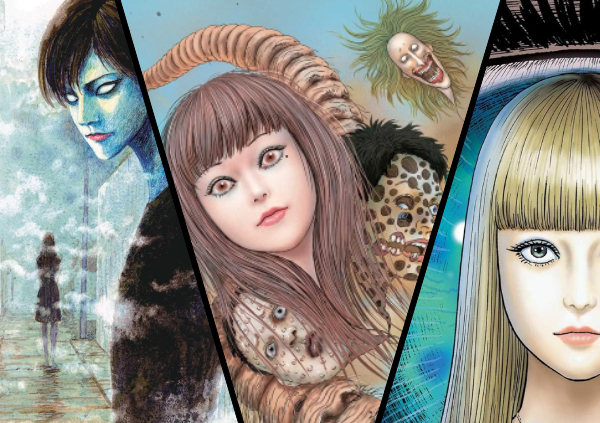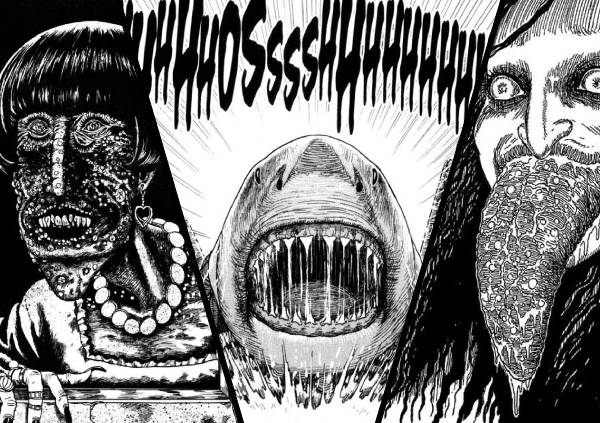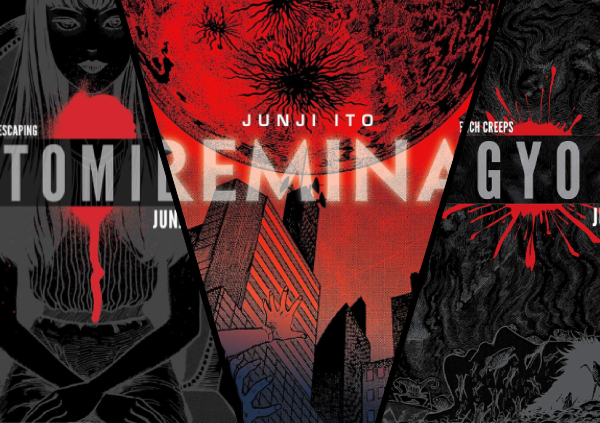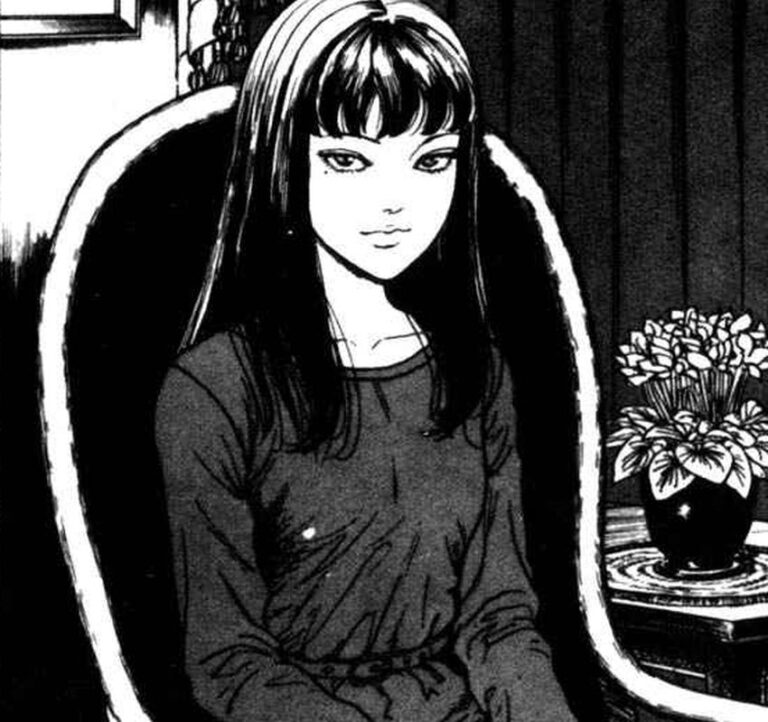I first discovered Junji Ito almost two decades ago, and I’ve been hooked ever since. His unsettling worlds, grotesque imagery, and sheer strangeness set him apart as not just Japan’s greatest horror manga artist, but one of the greatest horror creators of all time.

Ito’s works span the full spectrum of terror: body horror, phobias, psychological dread, and even cosmic horror. They’re as imaginative as they are disturbing, often blending surreal beauty with nightmarish imagery.
In this article, I’m ranking every Junji Ito collection currently available in English, from the unforgettable to the more uneven releases. Longer works like Uzumaki, Tomie, Gyo, and Hellstar Remina aren’t included here, as they deserve a dedicated list of their own.
If you want more Junji Ito recommendations, you can also read my complete list of the best Junji Ito stories and my in-depth essay on his style and recurring themes.
Here’s my personal ranking of every Junji Ito collection currently available in English (updated August 2025).
15. Dissolving Classroom

Dissolving Classroom might be one of Junji Ito’s strangest works, and, in my opinion, not in a good way.
It follows Yuuma, a mysterious young man who compulsively apologizes to everyone he meets, and his younger sister Chizumi, an unnervingly creepy child with a sadistic streak. It soon becomes clear that Yuuma’s endless apologies hide a sinister, supernatural effect.
This Junji Ito collection is packed with grotesque imagery: melting flesh, liquified brains, bodies dissolving into unrecognizable sludge. It’s horrific on a visual level, but the storytelling quickly becomes repetitive. By the first chapter, we already understand exactly what will happen to most characters. The final chapter attempts to shake up the formula, but it feels like too little, too late.
Yuuma’s apologizing grows more absurd than unsettling, while Chizumi’s over-the-top psychosis borders on comical. The volume also includes two bonus shorts, but they’re brief, forgettable additions.
While Dissolving Classroom has some memorable, stomach-churning moments, it remains one of the weakest Junji Ito collections. Recommended only for completists who want to experience all of Ito’s work.
14. Soichi

Soichi is one of Junji Ito’s most recurring characters. He’s a devilish boy with a love for curses, pranks, and general mischief. His tales are always strangely humorous, often walking the fine line between horror and comedy.
The stories follow Soichi as he torments family members, friends and strangers, often with elaborate schemes involving curses and creepy rituals. No matter how much chaos he causes though, there’s a strange cosmic justice at play, and Soichi always gets his comeuppance in one way or another.
The stories are by no means bad. In fact, Mannequin Teacher (Teacher of Cloth in the VIZ translation) is a standout for its sheer creativity, they’ve never worked for me personally. Soichi’s brand of horror leans heavily into absurdity and slapstick, and while I can see its appeal, it’s just too different from Ito’s more disturbing, atmospheric or existential works.
Yet if you enjoy dark humor mixed with grotesque visual gags, this collection might hit all the right notes.
For me, though, Soichi will always remain a curiosity. A memorable one, sure, but never a personal favorite.
13. The Liminal Zone Vol. 1

The Liminal Zone Vol. 1 is one of the most recently published Junji Ito collections, and while it boasts some truly stunning artwork, the storytelling is a mixed bag. The four stories here feel longer and more elaborate than his usual short works, but the extra page count doesn’t always work in his favor.
From the ever-crying women in Weeping Woman Way to the disturbing events at a Christian boarding school in Madonna, or the weird culmination of The Spirit Flow of Aokigahara, one can see Ito’s usual creativity at work. The problem is that all of these stories are full of narrative decisions that just don’t work, making them more baffling than memorable.
Even Slumber, my personal favorite, in which a man believes he’s a serial killer due to having memories of the brutal deeds he supposedly committed, veers more into absurdity than full resolution.
As a whole, The Liminal Zone Vol. 1 is worth reading for Ito’s art alone. It features some of his best and most intricate panels in recent years. Yet Ito’s always been stronger with visuals than narratives, and here, because of the stories’ page count, the imbalance shows.
There are flashes of brilliance in this Junji Ito collection, but they are weighed down by uneven storytelling.
12. The Liminal Zone Vol. 2

The Liminal Zone Vol. 2 is a step up from the first collection, but is still bogged down by some of the same problems. The visuals are again top-notch, and every story is dripping with Ito’s trademark blend of grotesque details and eerie atmosphere.
Monster King of Dust and The Shells of Manjunuma are the standouts here, offering both compelling imagery and a memorable storytelling. Village of Ether starts strong with one of Ito’s most outlandish and ambiguous ideas, but spirals into something overly chaotic near the end. Across the board, the stories share a willingness to experiment, yet the writing often stumbles, similar to the first volume of The Liminal Zone.
There’s a sense that Ito’s deliberately trying to branch out, tackling longer and more intricate storylines, but the execution doesn’t always land. Still, for fans of his art and unsettling imagination, The Liminal Zone Vol. 2 remains an interesting and visually satisfying Junji Ito collection.
11. Sensor

Sensor is one of Junji Ito’s more recent works, and visually, it might be his most beautiful yet. Rendered in his signature fine-lined detail, the art alone makes this Junji Ito collection worth flipping through.
The story is an ambitious blend of cosmic horror and philosophical musing, centering on a mysterious woman named Byakuya Kyouko. Themes of light versus darkness, the nature of the universe, and humanity’s place within give the narrative an almost mystical quality.
Sensor contains Ito’s usual trademark horror: melting flesh, grotesque insect innards, moments of body horror that unsettle on a visceral level. However, they are scattered throughout the broader, more abstract plot. The emphasis on contemplation rather than pure terror is intriguing, but it leaves the collection feeling less cohesive and horrifying than Ito’s strongest work.
Ultimately, Sensor is visually stunning but uneven. It’s worth reading for its art and ambition, though fans looking for consistent scares will find more satisfying options elsewhere in Ito’s bibliography.
10. Smashed

Smashed is one of the largest Junji Ito collections available in English, packing thirteen stories into a single volume. This should make it one of the most exciting releases for fans, but while there are some gems, the overall quality is uneven.
Standout tales like Bloodsucking Darkness, The Mystery of the Haunted House, and Earthbound showcase Ito’s ability to blend eerie premise with unsettling visuals. Unfortunately, most of the collection falls into more forgettable territory, with stories that never quite land the impact they promise.
As always, Ito’s artwork is consistently strong, with detailed linework and grotesque imagery that elevate even the weaker plots. But great art can only do so much when the narrative side is hit-or-miss, and in Smashed, there are simply too many misses.
In the end, Smashed is a decent collection, but it doesn’t reach the same heights as his best anthologies.
9. Mimi’s Tales of Terror

Mimi’s Tales of Terror isn’t the most famous Junji Ito collection, but it’s the one most rooted in Japanese urban legend. Across six eerie episodes, all linked by a soft-spoken yet oddly unlucky Mimi, readers are drawn into a quiet world where supernatural horror brushes up against the everyday.
Each tale works independently but shares the same lingering tone of unease: mysterious stalkers, a basement hiding sinister crimson stains, the vengeful ghost of a burned mother.
Among all these tales, The Seashore is my clear favorite as it delivers some of the most haunting, surreal visuals in the entire volume.
The stories here weren’t penned by Ito himself, but adapted from existing ghost stories, which means the plotting can feel uneven compared to the originals. Even so, his unmistakable art helps them shine, shifting seamlessly from subtle dread to full-on nightmare.
It may not reach the iconic heights of other Junji Ito collections, but it remains a chilling, folklore-infused read that shows how well Ito can channel traditional ghost lore through his singular visual style.
8. Deserter

Deserter is the newest Junji Ito collection by VIZ and contains twelve of his stories. While it contains its fair share of forgettable tales, it also contains some of his best ones.
Den of the Sleep Demon is a short, surreal, but incredible effective horror story. The Long Hair in the Attic is similarly creepy and brings forth some great body horror.
The two best stories in this collection, however, are Unbearable Maze and The Bully. Unbearable Maze tells the story of two young girls who end up at a strange meditation resort in the mountains. It features one of Junji Ito’s creepiest and greatest endings. The Bully, on the other hand, is one of the few Junji Ito stories that’s entirely grounded in reality. And yet, it proves to be one of his scariest, most twisted stories.
Overall, Deserter is a good collection, featuring some great stories.
7. Alley

One of the two most recent Junji Ito collections, Alley presents us with a varied mix from grotesque body horror to surreal social commentary. It’s an uneven set of Ito’s older works, but several stories rank among his most memorable.
Falling (Decent in the VIZ translation) is a chilling piece of cosmic horror. The Ward delivers one of Ito’s strangest hospital horror pieces, while Mold is revolting in the best way possible, and its visuals will linger with you for a long while. Town Without Streets (Town of No Roads in the VIZ translation) offers a brilliant and surreal nightmare of privacy stripped away. The Alley, the title story, is also one of the stronger entries. Similar to Ice Cream Bus, its simple setup rewards us with a surprisingly creepy execution.
The rest are more mixed, never quite landing or are not especially memorable.
As with much of Ito’s other work, Alley is carried by his impeccable art, turning even weaker entries into something worth staring at. While not all stories hit, the highlights make it a must-read for completionists and proof that even his older work still holds up today.
6. Fragments of Horror

Fragments of Horror was the first Junji Ito collection released in English. Before, only his longer, multi-volume works Uzumaki and Gyo had been released.
With only eight stories, it’s the shortest Junji Ito collection out there. While it features some weaker stories, like Magami Nankuse and Wooden Spirit, it also features some of Junji Ito’s best work.
Gentle Goodbye is one of the greatest stories he ever penned. It’s a sad, emotional work, a study of holding on and features a very special family ritual. Dissection-Chan, on the other hand, showcases one of Junji Ito’s most interesting characters with one of the most bizarre mental disorders ever. It also features one of his best body horror work of all times.
While Fragments of Horror is not an outstanding Junji Ito collection, it contains some fantastic stories and is well worth buying.
5. Tombs

A solid new Junji Ito collection, Tombs gathers several of the artist’s most iconic short works alongside a few underrated gems. For many readers, this volume will feel like a greatest-hits set, featuring Slug Girl and The Woman Next Door, two stories almost every Ito fan has heard of.
The title story, Tombs, centers on a town’s strange funeral practices, and what happens if they aren’t followed, while The Thing That Drifted Ashore (Washed Away in the VIZ translation) delivers some of his strangest deep-sea imagery. Bronze Statue might be one of Ito’s least-known stories, but features one of his most nightmarish sequences.
While smaller pieces like Clubhouse might not resonate strongly, they still add variety to the collection.
What makes Tombs stand out is its balance between well-known classics and lesser-discussed works, giving it appeal for both newcomers and longtime readers. It’s not his most consistent book, but with its mix of iconic scares and hidden treasures, Tombs earns its place as one of the more respectable and re-readable volumes in Ito’s library.
4. Frankenstein

Frankenstein is Junji Ito’s masterful retelling of Mary Shelley’s classic, and easily the best adaptation I’ve encountered. His art style and nightmarish imagery push the story far deeper into the horror genre, heightening the dread and tragedy in ways the original only hinted at.
Beyond the title story, this Junji Ito collection includes ten additional tales, most of them centered on one of his lesser-known recurring characters, Oshikiri. These stories are among his strangest, even by his own standards, weaving together hallucination, psychosis, alternate dimensions, and grotesque medical experiments. They also show some of Ito’s most disturbing and imaginative body horror.
Oshikiri might not be as popular as Tomie or Soichi, but his tales are as fantastic as they are bizarre, and it’s a thrill to have them finally available in English. Frankenstein stands out not only for its brilliant adaptation of a literary classic, but for its surreal and unsettling companion stories, making it a must-read for fans of Junji Ito’s work.
3. Lovesickness

Lovesickness centers on the eerie tale of the Intersection Pretty Boy, one of the first Junji Ito works I ever read, and one I still love to this day. While nostalgia might play a part, it remains a fantastic piece of horror, blending copious amounts of gore with a strange urban legend and a descent into insanity.
This Junji Ito collection also includes five additional stories, most notably featuring the twisted Hikizuri Siblings. These two tales are among Ito’s most warped creations, delivering pitch-black comedy and deeply unsettling scenarios. Another standout is The Rib Woman, a bizarre and outlandish concept that contains some of Ito’s most memorable body horror. In fact, The Rib Woman inspired one of my own short stories, Real Art Always Has a Price.
With one of Ito’s longer, more atmospheric works leading the way and several disturbingly inventive shorter pieces, Lovesickness stands as a highly recommended Junji Ito collection, especially for those who enjoy urban legends.
2. Venus in the Blind Spot

Venus in the Blind Spot is a more recent Junji Ito collection, and while a few shorter entries feel forgettable, its best stories rank among Ito’s all-time greats.
Anyone even passingly familiar with Ito has likely heard of The Enigma at Amigara Fault, a modern horror classic about our compulsive urge to uncover the unexplainable. Its surreal imagery and disturbing premise have cemented it as one of his most iconic works. In a similar vein, Army of One (Billions Alone in the VIZ translation) delivers another chilling, inexplicable phenomenon while also serving as a sharp critique of urban alienation and isolation.
The collection also includes The Human Chair, Ito’s superb adaptation of Edogawa Ranpo’s unsettling tale. Grounded in reality yet deeply unnerving, it showcases one of the most outlandish scenarios in fiction. On the more grotesque side, The Licking Woman takes a premise already disgusting and transforms it into something utterly horrifying through Ito’s art, culminating in a warped piece of body horror.
Though uneven in places, Venus in the Blind Spot shines for its masterful highlights, making it an essential Junji Ito collection for fans of both surreal and reality-based horror.
1. Shiver

Shiver is my all-time favorite Junji Ito collection, packed with some of his most unforgettable and disturbing stories.
It opens with Fashion Model, introducing Miss Fuji, one of Ito’s most iconic and unnerving creations. The Long Dream is another standout, a surreal and haunting meditation on the nature of dreams and morality, and easily one of Ito’s most original concepts.
My Dear Ancestors (Honored Ancestors in the VIZ translation) and Glyceride (Greased in the VIZ translation) rank among his most unsettling works. The former delivers a grotesque and bizarre scenario that lingers in the mind, while the latter may be the single most disgusting story he’s ever written. Both are brilliant examples of his mystery over horror. The title story Shiver blends greed, paranoia, and intense trypophobia into an unshakable piece of body horror.
For me, the collection’s best story is Hanging Balloons (Hanging Blimps in the VIZ translation), my favorite Junji Ito story of all time. Its premise is as bizarre as it is terrifying: mysterious floating balloons, each bearing a person’s face, hunt their human doubles to hang them.
Beneath the absurdity lies a chilling allegory for Freud’s death drive, and a sharp critique of Japan’s idol culture, though it’s just as effective when taken purely as apocalyptic nightmare fuel.
Shiver is the definitive Junji Ito collection, showcasing the best of his creativity, horror, and thematic depth. If you read only one, let it be this one.








